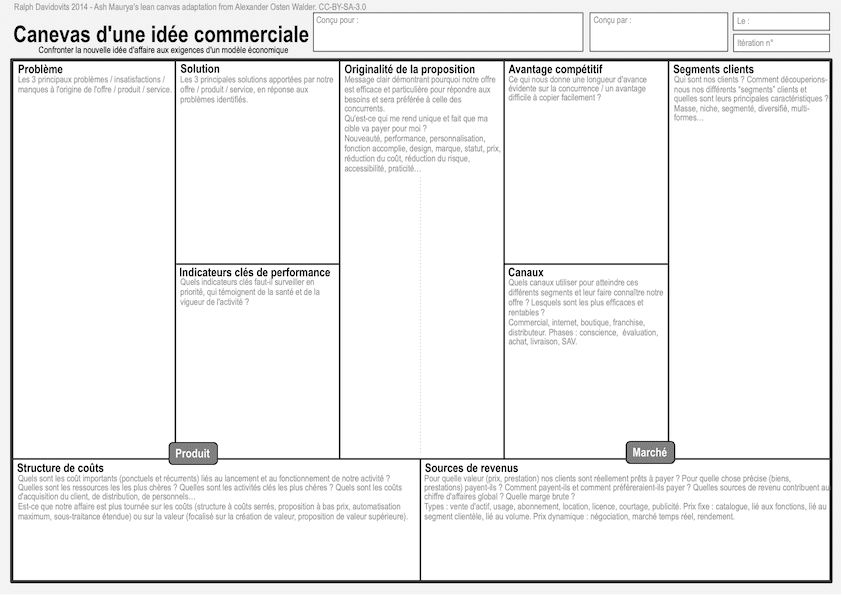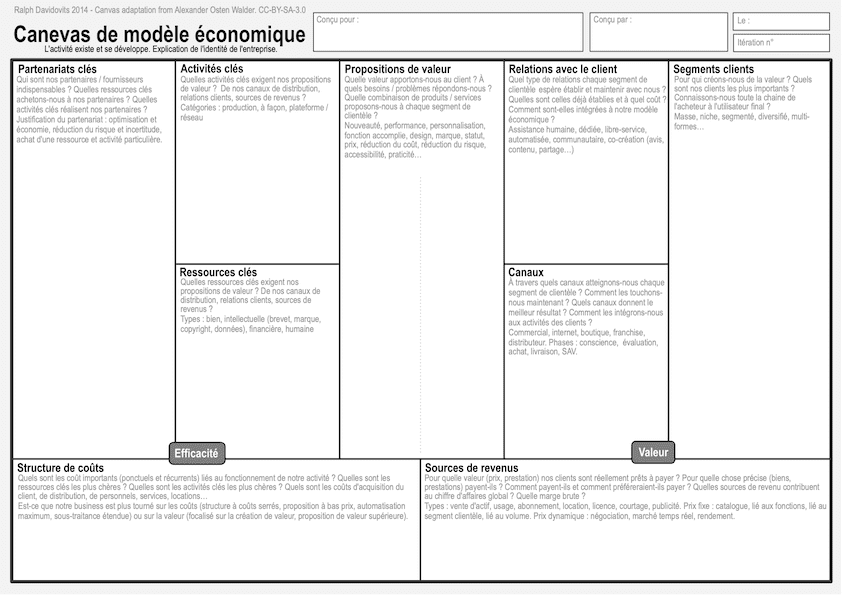Business Model Canvas to validate its relevance
Challenging one's business idea or start-up with reality, or defining a company's business model in order to evolve.

Evaluating and confirming your project
An entrepreneur always asks these three questions: Will the idea appeal to customers? Are we able to provide this product or service? Will the business be large enough to be profitable in the long term?
Experience has taught me that the two following templates will help you answer these three questions quickly:
- The business idea canvas: to challenge the new idea with the requirements of a business model.
- The business model canvas: when the activity already exists in order to understand the company's organization and identify possible evolution avenues.
I really like this concept of a one-page document template because it compels us to be concise so we don't get lost in incidental details. It makes it more accessible and quicker to present than a long file. This means that it will be read by a larger number of people and you will have more feedback and experience to help improve your project. Simple to fill in, it commits to preparing several versions until you are satisfied with its overview. Thanks to this one-page layout, you will be able to appreciate at first glance the coherence and relevance of the business model.
It will be necessary to fill in all the cells with care and honesty, and to find all the information necessary for good brainstorming. Justify that all assertions and hypotheses are proven and that they are not based on an opinion, a preconceived idea, a wish or an instinctive inspiration. Each piece of information will be verifiable, repeatable and testable to validate its reality. If the information is complicated to collect or non-existent, do not ignore it and include the unknown in the chart. Be very rigorous on this point, a false or very approximate statement will cause the failure of the project. The comments under each topic are very explicit and should be easy to understand. Be concise, but very specific. In business, lack of preparation comes at a high cost.
Non-commercial organizations such as associations or administrations can also benefit from the Business Model Canvas by making a few adjustments.
1. Business Idea Canvas
Who is it for?
This canvas is intended for the entrepreneur who wants to add a new product or service offering, and for the business creator who wants to test his idea or innovation in order to estimate its potential. Conceiving an innovative project and a new commercial offer require a variety of considerations, not always related to the creative idea, to achieve commercial success. Think of this canvas as simulating the creation of a new activity. The result will save you a lot of time.
How to get started?
The canvas is divided into two. The left half relates to the product and the right half to the market. To fill out this page, start with what is most important: the problem and the solution you are providing. Then follow the comments and collect the information needed to complete the other cells.
Detail of the canvas of a business idea
Unique value proposition: Clear and compelling message that states why our offer is effective and different to satisfy the needs, and will be preferred over the competition. What makes me unique and worth buying? Newness, performance, customization, getting the job done, design, brand, status, price, cost reduction, risk reduction, accessibility, convenience, usability…
Items relating to the Product
Problem: The 3 main problems / frustrations / lack behind the offer / product / service.
Solution: The 3 main solutions provided by our offer / product / service in response to the problems identified.
Key performance metrics: What key activities should be monitored in priority, which reflect the health and vigour of the activity?
Items relating to the Market
Unfair advantage: What gives us a clear competitive edge / can't be easily copied or bought?
Channels: Which channels to use to reach these different segments and raise awareness of our offer? Which ones work best and are cost-effective? Types: Salesforce, web sales, own stores, partners, wholesaler. Phases: awareness, evaluation, purchase, delivery, after-sales.
Customer segments: Who are our customers? How should we classify our different customer segments and what are their main characteristics? Mass, niche, segmented, diversified, multi-sided platform…
Financial items
Cost structures: What are the most important costs (limited and recurring) related to the start and regular business activity? Which key resources are the most expensive? Which key activities are the most expensive? What are the customer acquisition costs, distribution, salaries… Is our business more cost-driven (leanest cost structure, low price value proposition, maximum automation, extensive outsourcing) or value-driven (focused on value creation, premium value proposition)?
Revenue streams: For what value (price, service) are our customers really willing to pay? For what (goods, services) do they currently pay? How are they currently paying and would prefer to pay? How much does each revenue stream contribute to overall revenues? What is the gross margin? Types: Asset sale, usage fee, subscription fees, renting, leasing, licensing, brokerage fees, advertising. Fixed pricing: list price, product feature dependant, customer segment dependent, volume dependent. Dynamic pricing: negotiation, bargaining, real-time market, yield management.
Additional questions to assess the quality of the idea:
- Have we identified a unique opportunity that is true, that few or none believe to be true, an area where nobody else is looking?
- Are all the assumptions and assertions critical to the success of the project verifiable, testable and repeatable?
- Does our business create a breakthrough technology or incremental improvements?
- Is our proprietary technology far superior and much better than its closest substitute in some important dimension to lead to a real competitive or monopolistic advantage?
- Are we starting with a big share of a small market but that can grow, or are we starting in a competitive market with high risk to give up profits with time?
- Will our market position be defensible in the next 10 and 20 years?
- Is now the right time to start our particular business?
- Do we have the right team?
- Do we have a way to not just create but deliver our product?
- To reduce the risk, can the idea be developed with a first customer?
- Find a pioneer customer willing to pay for this new idea;
- Develop with early adopters a minimum viable product / service with essential features;
- Test and measure satisfaction, adapting our offer accordingly;
- Then, after validation, getting from prototype to market.
Origin of the canvas
This canvas is a tool based on the work of Ash Maurya on Lean Startup and on the canvas of Alexander Osten Walder which I have extended with comments and examples so as to understand how to fill in the blanks, and then I have added 10 questions to help you assess the quality and relevance of the idea. I have translated these documents into English and French to share them with more people.
2. Business Model Canvas
Who is it for?
This canvas is aimed at two distinct audiences.
The first audience is the entrepreneur himself. When he is asked what his business model is, the answer is often puzzled, as he does not have a clear vision of the organization and the way in which he achieves turnover. However, this vision is essential when decisions have to be made about the company's strategy. If the entrepreneur is constantly thinking about how to run his business and find new opportunities, if he is looking to improve or transform his organization, or if he is trying to design innovative ideas to do business and replace an obsolete scheme, this framework will help him in his thinking.
The second audience is investors and buyers who need a global view of the company, to understand its identity (i.e., its business model) in order to decide whether it is appropriate to invest. This canvas is therefore a kind of survey that will have to be completed by a classic financial audit.
Non-commercial organizations such as associations or administrations can also benefit from the Business Model Canvas by making a few adjustments. There is no Customer Segments but Beneficiaries. There is no Value Propositions but an Effective Fulfilled Mission that really is advantageous to the beneficiaries. There is no Revenue Streams but a Funding Budget that covers costs. This canvas is helpful to organizations that understand and apply these key concepts: in order for the beneficiaries to widely adopt the delivered service, the mission must respect the principles of efficiency and simplicity.
How do I get started?
The canvas is divided into two. The left half refers to efficiency and the right half to value. To fill out this page, start with what matters most here in the centre of the plan: the Value Proposition. What do you deliver to the customer to make them agree to pay for your product or service? Next, follow the comments and collect the necessary elements to complete the other cells.
Detail of the business model canvas
Value propositions: What do we deliver to the customer? Which one of our customer's problems / need are we solving / satisfying? What bundles of products /services are we offering to each customer segments? Newness, performance, customization, getting the job done, design, brand, status, price, cost reduction, risk reduction, accessibility, convenience, usability…
Items relating to Effectiveness
Key partners: Who are our essential key partners / suppliers? Which key resources are we acquiring from partners? Which key activities do partners perform? Motivation for partnerships: optimization and economy, reduction of risk and uncertainty, acquisition of particular resources and activities.
Key activities: What key activities do our Value Propositions require? Our distribution channels, customer relationships, revenue streams? Categories: production, problem-solving, platform / network
Key resources: What key resources do our Value Propositions require? Our distribution channels, customer relationships, revenue streams? Types: physical, intellectual (patent, brand, copyright, data), human, financial.
Items relating to the Value
Customer relationships: What type of relationship does each of our customer segments expect us to establish and maintain with them? Which one have we established and at what cost? How are they integrated with the rest of our business model? Personal assistance, dedicated, self-service, automated services, communities, co-creation (review, share, content)
Channels: Which channels to use to reach these different segments and raise awareness of our offer? Which ones work best and are cost-effective? Types: Salesforce, web sales, own stores, partners, wholesaler. Phases: awareness, evaluation, purchase, delivery, after-sales.
Customer segments: Who are our customers? How should we classify our different customer segments and what are their main characteristics? Mass, niche, segmented, diversified, multi-sided platform
Financial items
Cost structure: What are the most important costs (limited and recurring) related to regular business activity? Which key resources are the most expensive? Which key activities are the most expensive? What are the customer acquisition costs, distribution, salaries… Is our business more cost-driven (leanest cost structure, low price value proposition, maximum automation, extensive outsourcing) or value-driven (focused on value creation, premium value proposition)?
Revenue streams: For what value (price, service) are our customers really willing to pay? For what (goods, services) do they currently pay? How are they currently paying and would prefer to pay? How much does each revenue stream contribute to overall revenues? What is the gross margin? Types: Asset sale, usage fee, subscription fees, renting, leasing, licensing, brokerage fees, advertising. Fixed pricing: list price, product feature dependant, customer segment dependent, platform / network. Dynamic pricing: negotiation, bargaining, real-time market, yield management.
Additional questions to assess the quality of the business model:
- How many people or companies are there with a similar job-to-be-done (market size)?
- How well (delivery, cost, quality…) our Value Proposition is getting our customer's job done?
- How important this job really is for the customer and if he actually has a budget to spend on it?
- How much do switching costs prevent our customers from switching?
- How scalable is our business model, and can it grow?
- Does our business model produce recurring revenues?
- Do we earn (against equity capital or through customers) before we spend?
- How much do we get outsiders (customer or others) to do part of the work?
- Does our business model provide built-in protection from competition?
- Is our business model based on a game-changing cost structure?
Origin of the canvas
This framework is a tool based on the work of Alexander Osten Walder on the framework Business Model Generation which I have extended with comments and examples so as to understand how to fill in the blanks, then I have added 10 questions to help you assess the quality of the economic model. I have translated these documents into English and French to share them with more people.
“If-” you'll be a Man…
Re-discover Rudyard Kipling's famous poem “If- you'll be a Man, my son” which has inspired so many generations. It celebrates the courage to overcome hardship.
I've decided to succeed
I have put together 10 tried and tested tips for finding the will to successfully achieve your ambitions and overcome obstacles in your personal and professional life.
Gourmet treats
Exquisite recipes for mini-cakes (madeleines, financiers, biscuits, cakes, muffins) and other delicacies (croissants, brioche, traditional cakes…).

